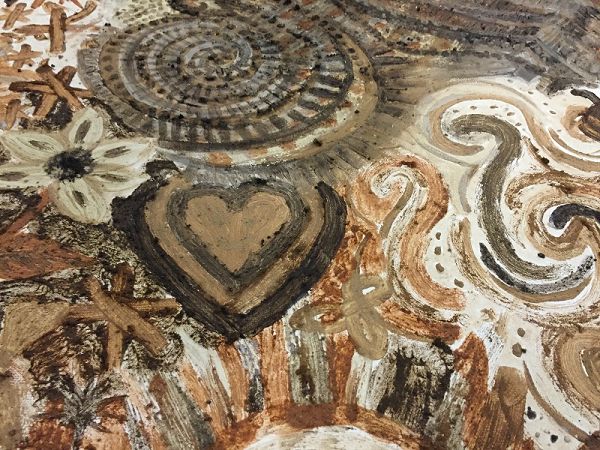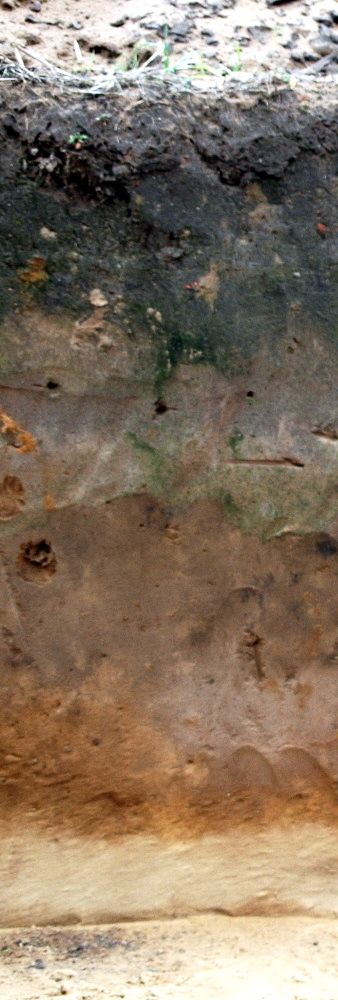Jan 31, 2016
To celebrate the Food and Agriculture Organization’s 2015 International Year of Soils, we are going to explore the question: why do soils look so different? Soils are an underappreciated, nonrenewable resource that provides the physical foundation and chemical compounds for all kinds of plant life. All soils are formed of rocks, minerals, and plant matter, so why do they look so different?
A mural painted with soils during World Soil Day during an event held by Cornell Soil Health.
Color is key
The color of a soil is a very distinguishing feature and can tell you about its history and chemical composition, generally speaking.
Dark brown to black. These colors are caused by decomposing organic matter (plants and animals). Dark, organic rich soils are common in the Great Plains states and at the Intensively Managed Landscapes CZO, but can also be found in seasonally wet areas. In wet conditions where oxygen can become limited, reduced iron and manganese can color soils jet black.
Red. Iron can turn soils red in the presence of oxygen and water (think rust). Red soils are common in tropical and subtropical regions, including the Luquillo CZO and Calhoun CZO.
White. In dry environments, calcium carbonates (seashells) and gypsum (commonly used as blackboard chalk) can color soils white. Porcelain-white soils are common in the arid regions of Nevada, California, and Arizona.
Green and more. A wide variety of other colors are possible under the right conditions, but the above descriptions are the main causes for color.
Soil color can also give hints to the age of a soil. Lighter colors are generally associated with younger soils due to low organic matter accumulation while older soils are redder because they have had time to accumulate iron oxides.
A more detailed explaination of soil colors is available on the USDA NRCS website.
Daniel Richter (Calhoun CZO) shows students an example of a highly eroded red soil profile in South Carolina. Photo: Jared Lazarus/Duke Photography
Layered colors = history
Vertical differences in soil color can also inform us about its history. Soil colors that are same with depth suggest the soils are young or well mixed. Think of a sand box or sandy beach. If there is a constant mixing of the sand from children digging or waves, the materials do not have time to form any layers.
Only with the establishment of grasses, shrubs or trees to physically hold materials together can horizons begin to take form. In addition, a constant source of organic matter and chemical inputs lead to formation of distinctive layers. The accumulation of organic matter is especially important because it causes soils to clump and eventually form a layer that we commonly refer to as topsoil (more formally known as the "A" horizon).
The key process driving the colors and horizons well below the soil surface is the downward movement of materials by water, known as leaching. Leaching can turn deeper horizons different colors and form different shapes, depending on the compounds being moved downward.
Additional information about soil processes can be found in the college section of the USDA NRCS website.
---
In summary, soils look different because they are exposed to a diverse set of conditions. However, it is their similarities that have allowed us to draw overall conclusions about why they look different. The color of a soil can hint at its composition and even its age. For soils to form the unique and different horizons in the profile, it requires time for the different materials and chemical compounds to accumulate. Although we can generalize how a soil looks, each soil is unique in its own way.
Have any questions swirling in your noodle about the rock, soil, water, fauna, or flora of the critical zone? Send them our way at Askcriticalzone@gmail.com
Science on!
Justin Richardson
Critical Zone Observatory Post-Doctoral Fellow
This material is supported by the National Science Foundation. Any opinions, findings, conclusions, or recommendations expressed in the material are those of the author(s) and do not necessarily reflect the views of the National Science Foundation
A mural painted with soils during World Soil Day during an event held by Cornell Soil Health.
Daniel Richter (Calhoun CZO) shows students an example of a highly eroded red soil profile in South Carolina. Photo: Jared Lazarus/Duke Photography
"Profil glebowy" by Radosław Drożdżewski (Zwiadowca21) - Own work. Licensed under CC BY-SA 3.0 via Commons - Link

Justin B. Richardson
CZO INVESTIGATOR, STAFF. National Office outreach officer, Former CZO Post-Doctoral Fellow. Specialty: Soil biogeochemistry of plant-essential and toxic metals.
Soil Science / Pedology EDUCATION/OUTREACH General Public
COMMENT ON "Adventures in the Critical Zone"
All comments are moderated. If you want to comment without logging in, select either the "Start/Join the discussion" box or a "Reply" link, then "Name", and finally, "I'd rather post as a guest" checkbox.
ABOUT THIS BLOG
Justin Richardson and his guests answer questions about the Critical Zone, synthesize CZ research, and meet folks working at the CZ observatories
General Disclaimer: Any opinions, findings, conclusions or recommendations presented in the above blog post are only those of the blog author and do not necessarily reflect the views of the U.S. CZO National Program or the National Science Foundation. For official information about NSF, visit www.nsf.gov.
Explore Further





